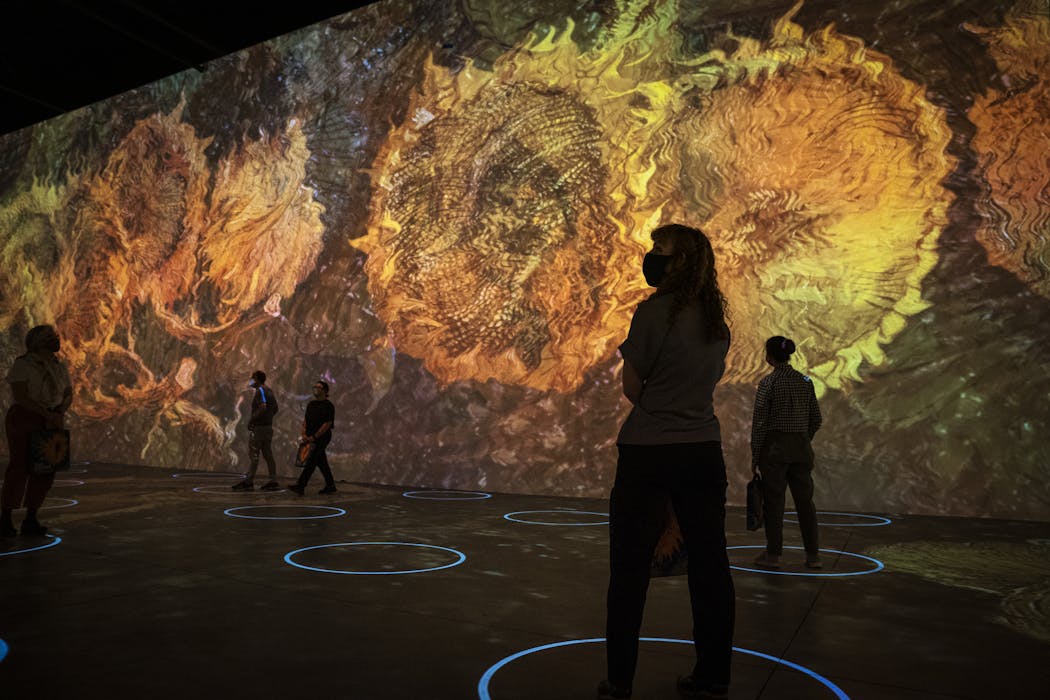Sitting on a cold floor inside a huge warehouse space, I listened to a dramatic orchestral soundtrack while watching a grassy field dissolve into paintings of quaint 19th-century France. As the projected fragments of Van Gogh artworks covered the walls, I realized that my neck was strained from looking up, and I had a pounding headache.
After a year and a half of seeing art mostly on screens due to the pandemic, it's ironic that people would willingly pay up to $50 to see "Immersive Van Gogh," a heavily marketed visual "experience" with several versions popping up in 29 cities across the United States. The show finally arrived in Minneapolis after the opening date was pushed back twice, from Aug. 2 to Aug. 12. It opened Aug. 13 after securing a necessary city permit.
Here, images from 400 of the artist's works take over the walls, ceiling and floors of Lighthouse Minneapolis (advertised as a "secret location" until late June). But the atmosphere of the space made this feel like a tragic combination of a bad rave and a haunted house at the Minnesota State Fair.
Defenders of "Immersive Van Gogh" claim that it's a cool way to experience popular art, a fun family or group activity, and that seeing it will "inspire people to learn more about Van Gogh." I disagree. This show is not about experiencing the artist's thick use of paints, his struggles with mental health, or his expressive and vivid post-Impressionist masterpieces. It's about creating a spectacle out of his art and exploiting it for marketing purposes.
Watching a portrait of Van Gogh in a straw hat with candles on the brim pop up and then disappear felt as empty as cruising through virtual museums during the pandemic, everything flattened. But unlike those free tours, this one cost nearly four times as much as entry to the Walker Art Center, where you can see real art.
The marketing team of "Immersive Van Gogh" asks visitors to take pics and post on social media, thus creating free advertising for the show. Giant mirrors make this even easier. As I watched a high-definition reproduction of cicada wings, plucked from "Three Cicadas," I thought of how anything educational had been sucked out. Like the shell of a cicada, already vacant.
Somewhere in the hazy experience, the madness of lights flashed some Van Gogh paintings that felt vaguely familiar. I saw "Postman (Portrait of Joseph Roulin)," Van Gogh's portrait of a burly red-haired bearded man wearing a blue cap. That guy! I noticed Van Gogh's "Bedroom at Arles" with its iconic red bed. Cool bedroom! But all chopped up and without context, this just felt like a maniacal and way-too-long TikTok video.
Bored and tired, I took out my phone and snapped a selfie in front of a mirror and posted it to my Instagram Stories, telling people not to go.
The only saving grace is the lobby, where talented Bay Area-based scenic designer Randy Wong-Westbrooke's large-scale, prop-like Van Gogh-themed works greet visitors. Van Gogh's love of thickly textured paint, known as impasto, is brought to life through a collection of paint swaths positioned vertically on a wall, with a palette knife sticking out of it. In the middle of the lobby, there is a fun, 8- by 8- by 7-foot version of Van Gogh's art box, filled with giant metal paint tubes. A painting of "The Red Vineyard," the only one Van Gogh may have sold in his lifetime, is located on the inside of the open lid.
It's depressingly ironic that Van Gogh, who died broke and unknown, is now making other people a lot of money.
So, should you Gogh? Please no. Art museums took major hits during the pandemic and I suggest you use your $40 to $50 to support them. They need it more than this sad excuse for art.
—
Immersive Van Gogh
Where: Lighthouse Minneapolis, 1515 Central Av. NE.
When: Ends Oct. 31.
Info: vangoghmsp.com.
Cost: $39.99-$49.99.

The 5 best things our food writers ate this week

A Minnesota field guide to snow shovels: Which one's best?

Summer Camp Guide: Find your best ones here

Lowertown St. Paul losing another restaurant as Dark Horse announces closing



